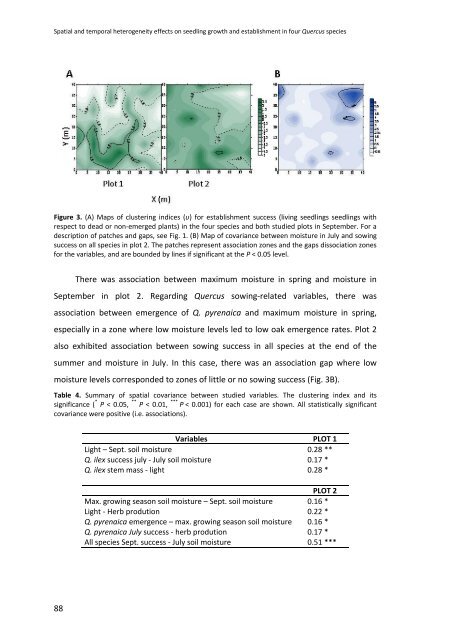Establecimiento de cuatro especies de Quercus en el sur de la ...
Establecimiento de cuatro especies de Quercus en el sur de la ...
Establecimiento de cuatro especies de Quercus en el sur de la ...
You also want an ePaper? Increase the reach of your titles
YUMPU automatically turns print PDFs into web optimized ePapers that Google loves.
Spatial and temporal heterog<strong>en</strong>eity effects on seedling growth and establishm<strong>en</strong>t in four <strong>Quercus</strong> species<br />
Figure 3. (A) Maps of clustering indices (υ) for establishm<strong>en</strong>t success (living seedlings seedlings with<br />
respect to <strong>de</strong>ad or non‐emerged p<strong>la</strong>nts) in the four species and both studied plots in September. For a<br />
<strong>de</strong>scription of patches and gaps, see Fig. 1. (B) Map of covariance betwe<strong>en</strong> moisture in July and sowing<br />
success on all species in plot 2. The patches repres<strong>en</strong>t association zones and the gaps dissociation zones<br />
for the variables, and are boun<strong>de</strong>d by lines if significant at the P < 0.05 lev<strong>el</strong>.<br />
There was association betwe<strong>en</strong> maximum moisture in spring and moisture in<br />
September in plot 2. Regarding <strong>Quercus</strong> sowing‐r<strong>el</strong>ated variables, there was<br />
association betwe<strong>en</strong> emerg<strong>en</strong>ce of Q. pyr<strong>en</strong>aica and maximum moisture in spring,<br />
especially in a zone where low moisture lev<strong>el</strong>s led to low oak emerg<strong>en</strong>ce rates. Plot 2<br />
also exhibited association betwe<strong>en</strong> sowing success in all species at the <strong>en</strong>d of the<br />
summer and moisture in July. In this case, there was an association gap where low<br />
moisture lev<strong>el</strong>s correspon<strong>de</strong>d to zones of little or no sowing success (Fig. 3B).<br />
Table 4. Summary of spatial covariance betwe<strong>en</strong> studied variables. The clustering in<strong>de</strong>x and its<br />
significance ( * P < 0.05, ** P < 0.01, *** P < 0.001) for each case are shown. All statistically significant<br />
covariance were positive (i.e. associations).<br />
Variables PLOT 1<br />
Light – Sept. soil moisture 0.28 **<br />
Q. ilex success july ‐ July soil moisture 0.17 *<br />
Q. ilex stem mass ‐ light 0.28 *<br />
PLOT 2<br />
Max. growing season soil moisture – Sept. soil moisture 0.16 *<br />
Light ‐ Herb prodution 0.22 *<br />
Q. pyr<strong>en</strong>aica emerg<strong>en</strong>ce – max. growing season soil moisture 0.16 *<br />
Q. pyr<strong>en</strong>aica July success ‐ herb prodution 0.17 *<br />
All species Sept. success ‐ July soil moisture 0.51 ***<br />
88

















